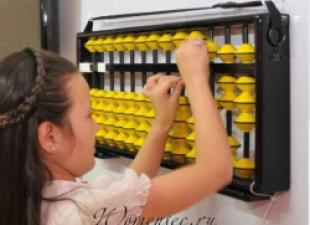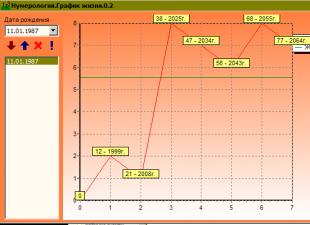How many Slavs have gods, who are they and what are they responsible for? Who is the main god?
Slavs, mostly linguistic group, and, of course, ethnic.
To say that there is an exact number of Slavic gods is simply impossible due to dialectology, ethnic characteristics and variations of cults. But, you can isolate the total layer of revered gods. They are Rod, Triglav, Sventovit, Belbog, Chernobog, Svarog, Lada, Stribog, Semargl, Perun, Velez, Makosh, Sharing, Nedolya, Cheese Mother Earth, Dazhbog, Yarilo, Kupala, Horse.
A complete description of these gods would have taken a decent place in our book, but this, unfortunately, does not fit the format. We will provide only a brief reference on the main gods.
Triglav - the essence of three gods, one and contradictory in their actions. This, for example: Svarog, Dazhbog, Perun (the rulers of heaven in different historical periods) or Lelya, Alive, Mara (metaphorical sisters - love, life and death). Triglavs were also called the cooperating spirits of fields, forests, farmsteads, etc., the months of the year that make up the season. Triglav is a trinity of the world, expressed in the functional of the gods.
Triglava mentioned Otto, the Bishop of Bamberg, in his description of the idol of the Temple of Retra: "There was also a three-headed statue, which had three heads on one body, called Triglav." Therefore, some researchers tend to believe that Sventovit trekhglavy.
Genus Supreme Deity, The creator of the universe. Source of everything. Father of Svarog and Lada. The One, the One, the progenitor of the gods and the creator of the world, “the Almighty, the one who is immortal and incorruptible, the creature, will blow the person on the face of the spirit of life, and live by man in the soul I live; in that children are born. ”
Helmgold reported: “Among the diverse deities to whom they devote fields, forests, sorrows and joys, they (the Slavs) recognize the one god who rules over them in the heavens, admit that he is almighty, cares only about the affairs of heaven. Other gods obey him, perform their duties, and that they come from his blood and each of them is all the more important the closer he stands to this god of gods. ”
Belbog also known as: White God, Sventovit, Svetovit, Svyatovid.
Color: White is a god of fertility (“good”) according to “Mater Verborum,” a god of fertility, and one of the sides of the Clan, as opposed to Chernobog. Mentioned in the "Slavic Chronicle" Helmold, described in detail in Saxon Grammar in the "Act of Dan," as the main god, god of the gods of the temple under Arkon.
It is he who is most often meant by the name Belobog among the Slavs. Sventovit is identified with the four-faced image of the upper tier of the Zbruch idol. The four-faced image of Sventovit stood in the famous Temple in the city of Arkona. Idol destroyed by Bishop Absalon in 1168
Chernobog (Tsarnib (balt.), Tiarnaglof, Zernoglov (balt.)) - God of Evil, lies, hatred, nights. Opponent Belobogs. Naviy (“evil”) god according to Helmold’s “Slavic Chronicle,” usually identified with the Blackhead from Knitlingasagi, has military functions.
In the Serbian Lusatian pantheon, it was named A.Frenzel (1696) - Czernebog. Peter Albin in the “Misney Chronicle” says: “For this, the Slavs worshiped Chernobog as an evil deity, that they imagined that all evil was in his power, and therefore they asked him for pardon, they reconciled him not to he hurt them. ”
Svarog - the male incarnation of the Sort, God the Creator, God of Heaven, wisdom, patron of marriage and blacksmithing, crafts. God established the law. Main after the kind, God demiurge. Patronized creative individuals. Spade Lada.
The creator god and legislator, the father of Svarozhichi, the demiurge, correlated with Hephaestus (“The Ipatiev Chronicle”, 1114 “i am on fire and chalice, and drink about idoleh svoih, having fun not being an essence of heretics ”) in a worldview that goes back to Orphic tradition, perhaps with Ilmarinen. He does not create with words, not with magic, unlike Veles, but with his hands, he creates the material world. The closest Vedic analogue is Tvashtar.
Lada - the goddess of love, the goddess of marriage according to “Mater Verborum” (correlated there with Venus) and “Synopsis”, as well as the “Tale of building a Benedictine monastery on Bald Mountain” (16th century record), under the name Gardzyna (“Guardian”) is mentioned in Polish Vedic rites of the early fifteenth century. Her month is April. One of the elk-grandmothers. Corresponds to Lato (Lado) from the country of hyperborea in the upper incarnation, and Demeter in the lower incarnation. One of the Rozhanits. According to B.A. Rybakov Lada - the great goddess of spring-summer fertility, patroness of weddings, marriage life. Often the fret is depicted with a cornucopia, which is fundamentally not true (This is how Mokosh is portrayed).
Semargl according to the official point of view, it is the god of the seeds and, accordingly, the harvest. Rybakov endowed Semargla with protective functions. Semargl guarded the harvest - the main value for the pagan - plowman.
In neo-paganism, Semargl acts as the God of fire, fiery requirements, warmth, blacksmithing, the patron of altars. God is the mediator between the world of people and the world of Gods.
Mentioned in the word of the Christ-lover is “they believe ... both in Shem and Rygla (Yergla)”. In later works, one name is used - C (e) Margl or Semurgl. A.S. Famintsyn believed that the letters "ь" and "g" appeared due to the copyist's error, instead of s (ery).
Stribog - the god-father, the old god, the grandfather of the winds, is mentioned in “The Lay of Igor's Regiment” (“Behold the wind, stribozhi vnutsi, blow from the sea with arrows on the brave regiment of Igor”). According to T.V. Gamkrelidze, etymologically, the name "Stribog" goes back to the Indo-European word * dievas-pater - Heaven-Father. Associated with the Moon Cult, the constant remembrance of Stribog next to Dazhbog, the solar deity, suggests just this thought: “I’d used to sacrifice the idol ... Stribog, Dazhbog and Perepluta believe, and spinning his ilk on his lips” (Let. Rus. Lit. t. IV, 99, 108-09).
Makosh (Makosh, Mogosh, Makosh, Puges (hunt.), Velesynya, Mogusch, Mokoshka (Sloven.), Verpei (lit.), Map (Latvian.) - Goddess of Fate, Happiness / Unhappiness, Women's Share, Divination, Handicraft, patroness of springs and holy wells, guardian of cows. Hypostasis Shares and Nedoli.
According to M. Fasmer, the word “Mokosh” comes from “wet” (at the same time, it is possible to communicate with the non-preserved root * mokos, “spinning”).
Mother Cheese Earth. Al. Sobolev in the brochure “The Underworld according to Old Russian Concepts” wrote that the earth was not soulless for the pagans. They endowed her with feeling and will. She was approached during the harvest, beginning to speak from the evil forces, believed in her life-giving and considered her a source of power.
The greatness of this deity can be seen in the late ideas of the Slavs about the afterlife. "Whoever bows to his son will not bow to Mother Raw Earth, on the coffin of that she will lay down not with down light, but with a heavy stone."
Perun (Thunder, Peren, Pyarun (Belor.), Peron, Ferry (slov.), Peraun (Czech), Piorun (Polish.), Perkunas (lit.), Perkons (Latvian.)) - God of thunderstorms, fertility, war , patron of warriors, fire, strength, power, law, life, weapons, martial art, patron of the harvest, beneficiary, rain. Son of Svarog. Brother rival Veles. Spouse Dodola.
The mention of Perun is found in the PVL: under 6415 (907), “... and his men, according to the Russian law, swear by their arms, and by Perun, their god, and Volosom, scum god, and affirm peace”.
Velez (Volos, Velnjas / Velns / Velinas / Velnjas (lit., Latvian.)) - God of cattle, shepherds, wealth, clouds, cunning, bookishness, guarding, living, will, trading, witchcraft, fortune telling, conductor of dead souls. God of worldly wisdom and all life. Analog - Hermes.
It is interesting to mention Veles in the “Lay of Igor the Regiment”: “There was something in the experience, Bojana's things, Velesov’s granddaughter”. Some scholars tend to believe that the image of Veles is poetic and some of its functions are associated with lyrics.
Dazhbog, Daibog, Dajbo, Even, Dazbog, Dazhba, Dashuba, Dabog (Serb.), Daba, Daibbog (Serb.). Dazhbog - God of the sun, light, good, good, rain, patron of weddings, nature, wealth, giving, help. Son of Svarog.
God of fertility and sunshine and life-giving power, correlated with Helios, the grandfather of the Slavs. (“Ipatiev Chronicle”), Progenitor of the Slavic clan according to “The Word about Igor's Regiment”: “Then, under Olze Gorislavlich, he sows and strikes, perishes the life of Dazhbozh's grandson, in princely seditions, make a man of prints”.
Lelya (Lola, Lyalya (Belor.)) - The goddess of maiden love, the younger Rozhanitsa, patroness of lovers, wealth, beauty, happiness.
Based on wedding songs Lelia and interpreted as the goddess of love.
A feature of many-sided Lela in all Her incarnations is Youth - since this is the main feature of this Goddess. Unlike all other goddesses and gods, whose temper is often seen as harsh or serious, Lele is characterized by a cheerful disposition and playfulness.
Mara (Marin; Marzana, Marjana, Margene (Polish), Muriena / Marmuriena (slov.), Mary (Latvian), Smrtonoska (Czech), Marysia (Belor.)) - Goddess of Death, disease, cold, winter, evil , nights, darkness, black witchcraft, anger.
Mara - one of the most ancient, mysterious and “vague” deities in Slavic pagan beliefs. Mara is a goddess in the form of a tall woman or, on the contrary, a hunched old woman, but with long flowing hair. Sometimes - a beautiful girl in white, sometimes a woman dressed in black dresses and torn clothes. In a later tradition, Maru was identified with Kikimora.
Is alive (Seewa (lit.), Zywye (Polish)) - Goddess of life, spring, fertility, birth, living grain.
Alive is the personification of the fruitful, spring force. The goddess of birth, life, beauty of all earthly, springtime.
The Slavs' beliefs are described in the Polish chronicle: “A temple was built for the Divine Givea on a mountain named for it Zywiec, where in the first days of May numerous people piously converged to that which they considered to be the source of life, long-term and prosperous health. Particularly sacrificed to her were those who heard the first singing of the cuckoo, who had predicted so many years of life, how many times her voice would repeat. They thought that the highest ruler of the universe turned into a cuckoo and he himself foreshadowed the continuation of life ... ”.
Horse (Chrsovik (Serb.), Horus (Czech)) - God of the winter sun, grains, winter crops, cold weather, patron of cattle (especially horses).
The god of the solar disk, mentioned in the Russian chronicles - the pantheon of the book. Vladimir Welcoming Khors, the Slavs led round dances and built sanctuaries for him - horomin, mansions. Such words are probably associated with his name in Russian, well, khorugv, chorus, the god of the world order associated with the course of the sun. The god Navi could be called, in contrast to him, the Black Khoros. The image dates back to ancient times.
Share and Nedolya Even in Orthodox churches, two rozhanits were depicted in decorative ornaments - a happy Piece and a dashing Nedoll (Church of the Savior on Ilyina, Veliky Novgorod, etc.). Although, this tradition is fixed mainly in embroidery and has survived to this day.
Fate is blind, they said: “Lazy man lies, but God holds a share for him”, - that is, it is received not for merit, but by random choice. It was believed that the fate can not escape, but still it could be improved or worsen with the help of certain rituals.
Radogast (Radegast. Radogoits, Radichost (balt.)) - According to Pistorius, the God of War. The West Slavic god, named Helmold in the Slavic Chronicle, 1167-1168, the god of the land of Baodrei. Often mentioned in the descriptions of the temple of Retra on the island of Rügen.
Yarylo - the god of fertility, an ardent god of awakening nature and the light of the spring, a wild, zealous Tour (Saxon Grammar, “Acts of Dan”, “Knitlingasaga”), the idol stood in Karenza (Kornitsa) on Rugen. The well-known ethnographer PS Efimenko said “About Yaril, the pagan deity of the Russian Slavs”. He noted that in its meaning the word “Yarilo” means the rapidly spreading spring or morning sunlight, which arouses plant strength in grasses and trees, carnal love in people and animals, then youthful freshness, strength and courage in man.
One question / polytheism is very controversial in scientific literature. From the history: Genotheism (Rhoteism) - a term proposed by Maximillian Muller in the 19th century in relation to the religions of India and Egypt. In part, genotheism is also inherent in the Slavic pantheon. It seems that assimilation cars are in the thesis about the kinship of the Slavic gods. But it is not fully realized in the Slavic pagan paradigm.
Much has been written by the classics of historical science.
Five centuries after Procopius, the German chronicler Helmold wrote about the supreme deity of the Slavs: “Among the diverse deities to whom they devote fields and forests, sorrows and joys, they recognize one God who dominates others in the heavens, they recognize that he is omnipotent, only cares about the affairs of heaven, they [the other gods], obeying him, carry out their duties, and that they come from his blood and each of them is the more important the closer he stands to this god of gods. ”
It is more or less clear with the god of gods, but we are faced with the following question: why did the Slavs worship different gods at different historical intervals?
The answer, it seems to me, lies in the question itself. Just the gods with different rulers put in first place on the basis of its functions. This reflected the prince’s domestic or foreign policy.
So originally the supreme god was Rod, the cosmogonic beginning, the god demiurge. Many modern researchers, though without proof, attributed to him the masculine and feminine principle and the name "Rodo". Anyway, Rod, according to a number of researchers, is the main Slavic god of gods. Then some time rules Svarog. This has a PVL certificate for 5622 (1114) year. Where they say: "after the flood and after the separation of languages, first began to reign Mestre, from the clan of Ham, after him Jeremiah, then Theosta, whom the Egyptians called Svarog." Then, the most vivid example of Perun. The cult of Perun is an artificial princely cult of warriors, but, oddly enough, it is his rule that many consider basic and unique. And he finishes the string of “rulers” Dazhbog who, according to the same PVL record for 1114: “After him (Svarog) his son reigned,“ by the name of the Sun, who is called Dazhdbog ”. I “placed” these gods in the order “from the ancient ...”. Hence the controversy about the supreme deity. That describes Osipova OS in the work “Slavic pagan worldview”: “In parallel, in the science of the XIX century, and later in the XX century, alternative points of view began to form. According to one of the researchers who defended the idea of Slavic Eneism, the God of Slavic gods was one of the main gods - Svyatovit, Svarog, Perun or Rod. Here you can name the names of Mikhail B. Nikiforovsky, Konstantin V. Bolsunovsky, Boris A. Rybakov, Ya. E. Borovsky, V. V. Sedov, V. V. Shuklin, G. S. Belyakova.
According to Maxim Zyryanov, which is based on the work of B.Rybakov, it can be concluded that there is no supreme god in Russia, and there has never been. For each person the supreme was his own god. As an example, for blacksmiths, Svarog was supreme, a god associated with fire, forge and creation. For the warriors, the supreme warriors were Perun, the god of warrior and protector.
Gods of Ancient Russia - GREAT WORKS + DESCRIPTION!Gods of Ancient Russia
ROD
Rod - is the main deity inslavic pantheon. The creator of all, the primary spirit, Vityaz Light.Rod was god sky, thunderstorms, fertility. It was said of him that he was riding on a cloud, throwing rain on the earth, and from this children were born. He was the lord of the earth and all living things, was pagangod of the creator.
In Slavic languages, the root "genus" means kinship, birth, water (spring), profit (harvest), such concepts asgenus and homeland, moreover, it means red color and lightning, especially ball, called "rhodium". This variety of cognate words undoubtedly proves the greatness of the pagan god. OtherThe gods gods descended from this, obey him and are all the more powerful than they stand closer to their Great Father.
By Rod there were many sons and daughters who are also the highestby gods : Svarog, Lada, Veles ...
The ancient sovereign takes care of the affairs of heaven. OtherThe gods obey only him and fulfill all the requirements unquestioningly.
PERUN
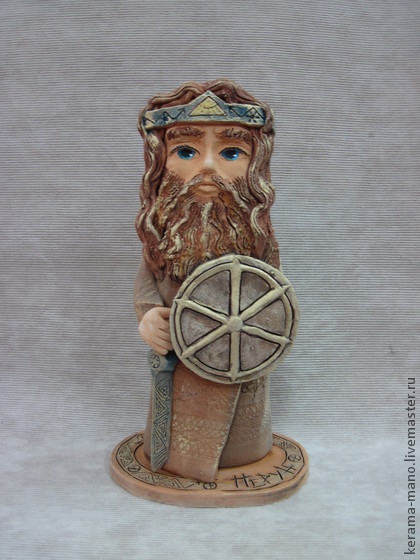
Perun is the god of the thugs in Slavic mythology.
In the All-Divine Ancestral Perun-Batyushka marks the Power and the [Explicit] Will,
Perun the Terrible, the Merciful Vicious of the Scribe, Slaying evil, Truth Might, Sky Shadow, Gaze of Light, Glory of the Clyagus, Volodetel Thundercrank, Shooter, Possessing Molony Arrows - Father of Victories, Golden Heaven Heavens, Exterior Covers.Russian princes.
Might, Strength, Will, Honor, Debt, Fidelity, Victory, Glory, Military skills, Right Court - this is what Perun-Batyushka gives to those walking by His Path.
Vedanie of Manifestations and Essence His has six main Faces - according to the number of parties in the Hexagonal Thunder Sign -Symbol denominations of his will.
Velez and Makosh with a "cornucopia"
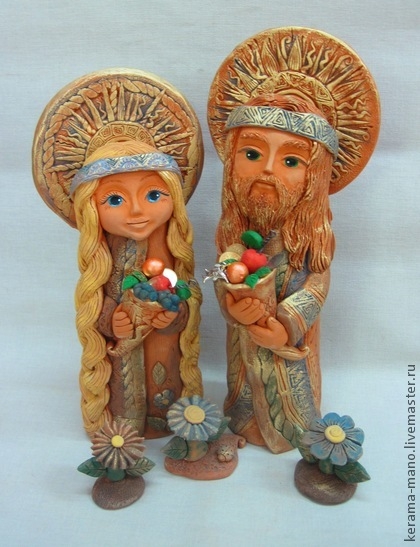
Makosh - Goddess family happiness, well-being, the keeper of the hearth .. Mokosh protects the house, grants peace and tranquilityfamily . . Mokosh is addressed for family happiness and for the welfare of children. She is the giver of all blessings, therefore, in Images and IdolsGoddess Bikini often depicted withHorn of Plenty. Cornucopia , filled with the fruits of the earth, is a symbol of not only prosperity and good luck, but also divine bounty.
Velez - one of the sunniestgods. Veles is the god of wealth and the husband of the goddess Mokos AdministeredVeles There are both earthly and underground riches - money, gold, jewels, oil.Veles - God of roads, paths, paths and travelers. If you get lost, go astray, finding yourself in an unfamiliar place, and do not know where to go next, mentally refer toGod Veles and the right way will be opened for you, you will make the right decision where to go, or someone will tell you and help you, and that person will be the messengerVeles. Through it Veles helps you. Veles - God healing and healththe God healers, medicine men and herbalists. He also patronizes farmers, merchants, musicians, poets, travelers, scientists, doctors, fortunetellers, soothsayers. . In the hands ofVeles cornucopiafilled with flowers and fruits of every kind. It is a symbol of wealth, generosity,abundance , all the best, happiness and generosity. The great estate acquired by labor, trade, power, power and victories. It is a symbolic sign of all the ancients.Gods
Slavic God "Veles"
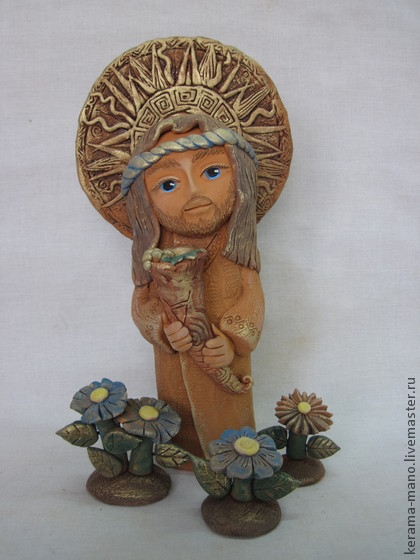
Velez - one of the sunniestgods. Veles - god wealth and husband of goddess mokos. Veles is in charge of both earthly and underground wealth — money, gold, jewels, and oil. Veles -the God roads, paths, paths and travelers. If you get lost, go astray, finding yourself in an unfamiliar place, and do not know where to go next, mentally refer toTo god Veles, and the right path will open for you, you will make the right decision where to go, or someone will tell you and help you, and that person will be Veles' messenger. Through it Veles helps you. Veles -the God healing and healththe God healers, medicine men and herbalists. He also patronizes farmers, merchants, musicians, poets, travelers, scientists, doctors, fortunetellers, soothsayers. . In his hands, Veles has a cornucopia full of flowers and fruits of every kind. It is a symbol of wealth, generosity, abundance, all the best, happiness and generosity. The great estate acquired by labor, trade, power, power and victories. It is a symbolic sign of all the ancients.Gods
Slavic goddess "Svoba"
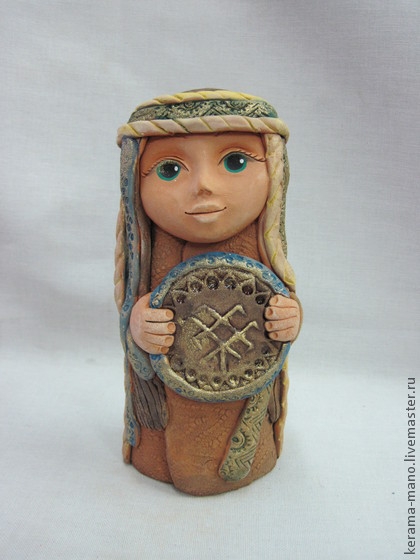
Freedom - slavic Goddess forests. Symbol in her hands - Fire Flower (fern flower) or Overgrown Grass - the mainamulet to protect against any ailments and ailments. A fire sign that can burn disease, purify body, soul, and revive the spirit. It has powerful healing power, is able to fulfill desires.
Mother Earth
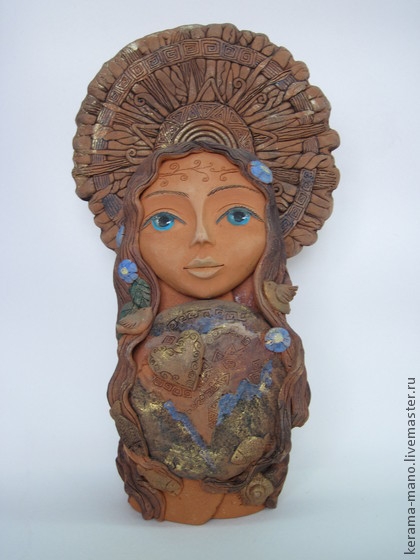
EARTH (Mother Earth) - has long been revered by man as the Mother Goddess. Earth - Cosmic Divine Being - Logos.
Mother Earth has its own kundalini. She is not just a dead earth. She understands, thinks, coordinates and creates. You can only discover this when you are a realized soul.
Nature was understood by the Slavs as an eternally creative force. The highest value for people was procreation - fertility. Hence the cult of the Earth - Mother-giver givinga life all living things, including man.
From time immemorial, the earth was considered both nature and a deity. Slavs called her Mother - that is, the mother of all living things. She was considered the very ancestorrussian people. In russian folk tales and epics land gave the hero great power, kept him, protecting from evil. A good young man will fall to the Mother Earth - and be filled with new strengths.
According to popular belief, the earthly flesh could give birth, that is, to become a Mother, only being irrigated with moisture. Hence the ancient name “Mother of the Cheese Earth”, the veneration of its fertility together with the worship of life-giving moisture and other elements.
Goddess "Alive"
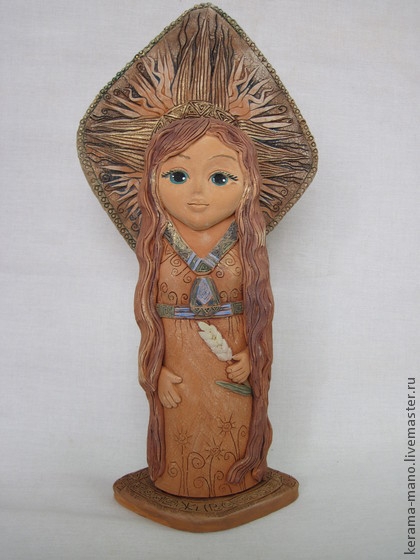
Goddess of life. It has a life-giving force, evoking not only nature, but also people's feelings. itGoddess
Gods of the Sun "Svarog, Lada and their daughter Lelya"
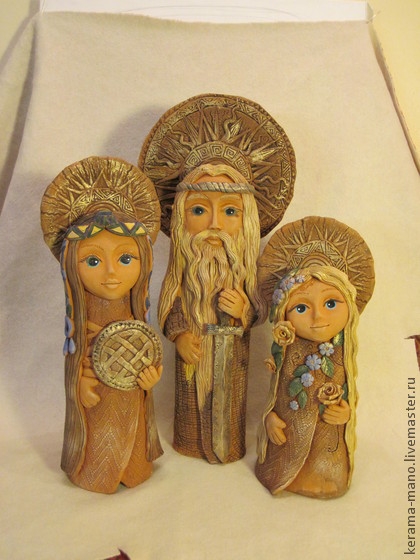
Svarog
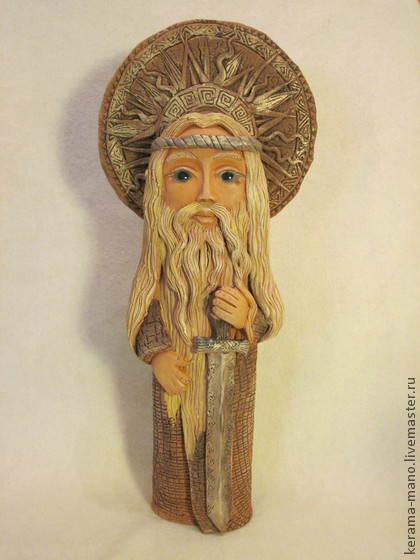
the God of the world - the father of allgods and spouse Lada. Svarog was the Slavsby god Heaven, the father of all things.the God fire element, wisdom, patron of marriage, oaths, crafts and hunters. Heavenly blacksmith and great warrior. Svarog is the owner and keeper of the sacred fire and its creator. It promotes the development of knowledge and the observance of God's laws.
Great Lada
Goddess spring-summer fertility. Patroness of weddings and marriage life. The Slavs called the name of the Lada the whole structure of life - LAD, where everything should be fine and
Great Lada
Goddess spring-summer fertility. Patroness of weddings and marriage life. Slavs called the name of the Lada the whole structure of life - LAD, where everything should be okay and good.
Lelya
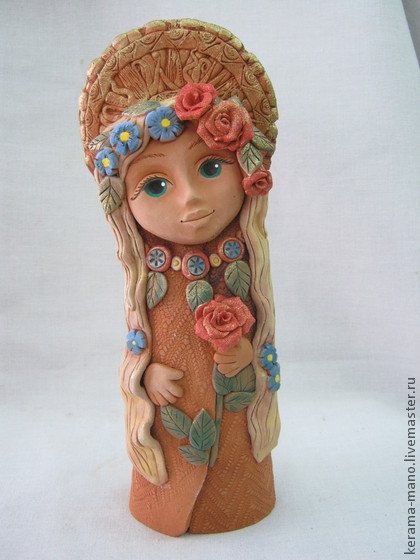
Daughter of the Goddess Lada and God Svarog. Lelia the goddess maiden love, patroness of lovers, wealth and beauty. Strength of thisgoddesses in the ignition of love between a man and a woman.
Slavic God "Kolyadnik"
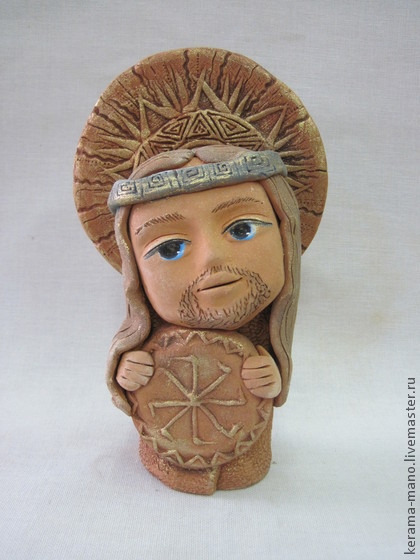
Slavic God Kolyada (Kolyadnik).
Performs updates on the ground and changes for the better. Symbol of victory of light over darkness. Is anmale talismanbestowing strength in creative work and victory over enemies.
Slavic goddess "alive"
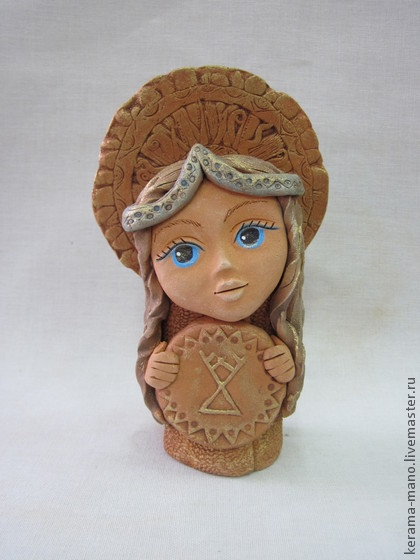
Goddess of life. It has a life-giving force, evoking not only nature, but also people's feelings. itGoddess Spring, fertility and birth. Patroness of young virgins and young wives.
Slavic God "Dazhdbog"
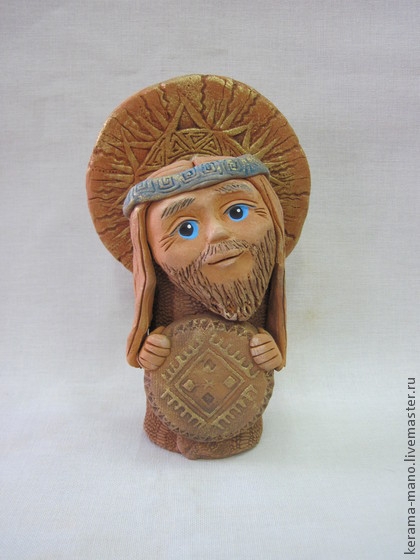
Dazhdbog is the highest being, giving people earthly benefits. God of fertility, sunshine and life-giving power. His name is explained as follows:
"Give" - give. "Bog" - happiness, well-being.
Slavic god "Volod"
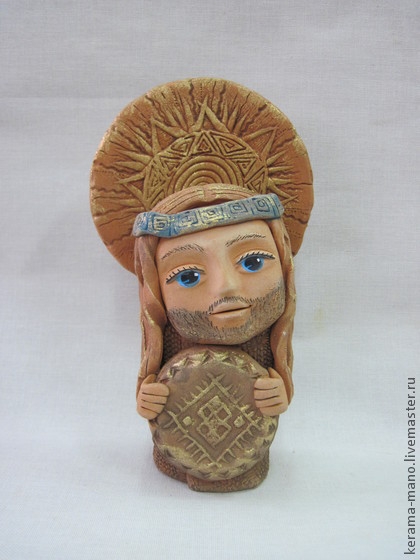
Slavic God Volod and the symbol, symbolizing it, from ancient times endowed man with a powerful hero, comparable toGods for doing good deeds and protecting the native land.
Velez
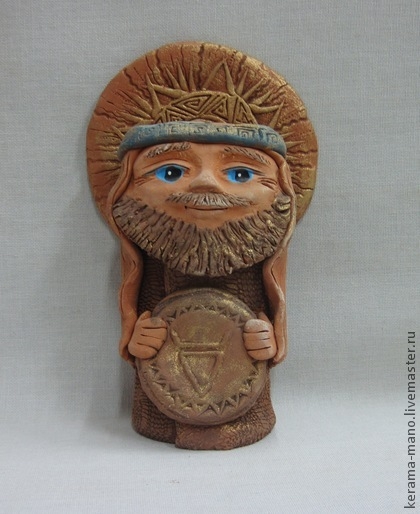
Veles (Volos) is the son of Rod, Hors brother. Veles is one of the most reveredGods . Velez stands on the border between Yavi and Navi, he is the essence of God's help to those who, walking by the Path of Rule, learn ancient wisdom, penetrating the subtle, naive world. Patron of livestock andwealth , the embodiment of gold, the trustee of traders, herders, hunters and tillers. All lower spirits obey him.
God symbol Veles - "Latin" letter "V", in general resembles a bull head -symbol of wealth, wealth, trade.
Ded Moroz and Snegurochka .
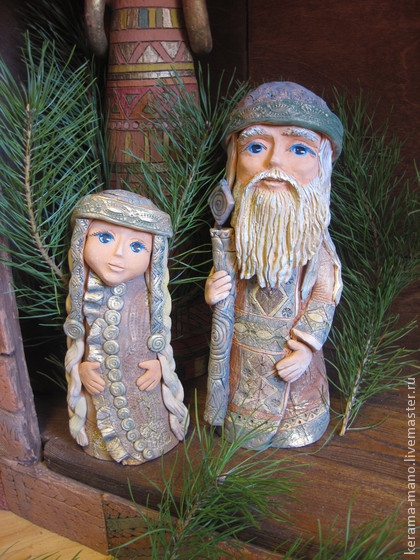
Santa Claus , Frost is one ofSlavic Gods. . Santa Claus Although it is God and the patron of the cold, it always serves this world, is one of the important Gods in this world and can help people. He presented himself as a mighty old wizard with a staff, in a rich and warm fur coat. Strict but fair, He will never leave in trouble people who honor him and know what he really is. It is also worth noting that, despite its cold incarnation,Santa Claus has a kind and warm heart.Santa Claus always enjoyed such fame and in this we can be convinced by readingrussian tales.
But it would be very lonelySanta Claus don't be near himSnow Maidens . And if some of our similaritiesslavic Father Frost under different names exist in many countries thenSnow Maiden - our purely Russian possession of great and generous truerussian spirit.
Paganism of Ancient Russia- the system of pre-Christian ideas about the world and man among the ancient Eastern Slavs, the official and dominant religion in the Old Russian state before the Baptism of Russia in 988. Up to the middle of the XIII century, despite the efforts of the ruling elite, continued to confess a large part of the population of Russia. After the complete suppression of Christianity, pagan traditions and beliefs continued to have a significant impact on Russian culture, traditions and way of life, which remains to this day.
Pantheon of gods
The beliefs of the ancient Slavs were rooted in the religious beliefs of the ancient Indo-Europeans, from which the Slavs stood out in the II-I millennium BC. e. Gradually transforming and becoming more complex, adopting features of other cultures, primarily Iranian-speaking (Scythians, Sarmatians, Alans), the system of pagan beliefs reached the IX-X centuries.
In the Laurentian Chronicle it is mentioned that in the Kiev pagan pantheon, staged by Prince Vladimir in 980 "on the hill beyond the courtyard of the court", the idols of the gods Perun, Hors, Dazhbog, Stribog, Simargla (Semargla) and Mokoshi were present. Perun was the supreme thunder god, the Slavic counterpart of Zeus and Thor. He was considered the patron of the princely family, he was worshiped primarily in the princely-armed environment. Horse played the role of the sun god. Researchers argue about the origin of his name, perhaps it came to the Slavs from the Khazars or the Scythians and Sarmatians. Dazhbog, who also personified the sun, some experts identify with Horse, believing that these are two names of the same god. Stribog was the god of the wind, Semargl, as some scholars believe, the god of vegetation, earth, and the underworld. The only goddess in Vladimir's pantheon was Mokosh, the patroness of crafts and fertility. A huge array of controversial scientific literature is dedicated to the “Gods of Vladimir”: experts offer many options for interpreting the names of pagan deities, talk about their tribal binding, and look for analogues in German, Baltic, Iranian, Finno-Ugric, Turkic cults. There is an opinion that the legend about the “gods of Vladimir” is a late insertion with the names of pagan idols known by various references. One way or another, archaeological excavations have shown that a Slavic temple really stood opposite the princely court on Starokievskaya Hill.
Of those Slavic gods that are not mentioned in the Laurentian Chronicle, the researchers single out the fire god Svarog, especially the peasant goddess of spring and marriage Lada, as well as Volos (Veles), the patron god of cattle breeding. Three of these gods, as well as Mokosh, Perun and Dazhbog-Khors, an outstanding scientist B. A. Rybakov "identified" on images from a stone idol of the 10th century, discovered in the river Zbruch (modern Ukraine) in 1848 and therefore went down in history as "Zbruch idol". It is noteworthy that the cults of different deities prevailed among the various Slavic tribes.
Lower deities
With a rather poor pantheon of gods, the pagans of Ancient Russia had a multifaceted lower sphere of mythology, which is uncharacteristic for most pagan religions. Some of the lower creatures personified nature and natural phenomena (goblin, water, field), others were associated with the house and household (house, bannik), others were endowed with demonic properties (witches, veshtitsy, pestilence, sorcerers, warlocks, as well as devils and demons ). The main witch in the pagan mythology of the Slavs was Baba Yaga, the invariable attributes of which were the hut on chicken legs, the bone leg, the stupa and the broom. Baba Yaga personified the restless soul, they brought bloody sacrifices to appease the sorceress. A kind of "double" Baba Yaga was Famously One-eyed. A significant role in Slavic mythology and mermaids played. It was believed that this is a drowned woman capable of luring a person into a swamp and tickling to death. The female characters were also goddesses — women who died in childbirth, prey on women in labor and abducting or replacing infants, and frighten living behind a stove or a shed and harming household members. After the adoption of Christianity and its assimilation by wide sections of the population of Russia, the previously harmless creatures who identified natural phenomena, such as the devil and the watery, acquired a demonic essence.
Entourage and attributes of the pagan cult. Magi
Folklore data allow us to say that the main objects of the cult of the ancient Pagan Slavs were the pillar, which the worshipers embraced, and the furnace, which they kissed. A characteristic Old Slavic rite was the Carnival, accompanied by the rolling of a wheel of fire, the burning of stuffed winter, fistfights and masks. Places for prayers tried to choose on the hills - hills and mountains. The stuffed winters were burned there and the spells of spring were held. In the lowlands, ceremonies were performed in the meadows. Sacred groves (“carvings”) and sacred trees (“trees”) also belonged to the category of places of worship. Especially revered trees were birch and oak, a symbol of the god Perun, as well as trees located near the springs and springs.
Calendar holidays and rites of ancient pagan Slavs had an agricultural background, many of them were also associated with the cult of ancestors. It was believed that the ancestors resting in the ground blessed the future harvest, therefore, to ensure fertility, the ancient Slavs sought to appease their deceased relatives: they were commemorated with Pancakes at Maslenitsa, and various competitions were dedicated to them.
Places of worship of ancient Slavs idols were open shrines - temples. In the center of the temple stood an idol. These sculptural images of deities, rather primitive in execution, could be both wooden and stone. A striking example of the idol of the ancient Slavs is the above-mentioned "Zbruch idol." The highlands were fenced, a fire was made inside. There is an opinion that in the North-Western Russia the role of shrines could play hills - embankments over burial grounds.
Old Russian pagan priests - a special category of persons serving the religious sphere - were called wise men. In the IX-X centuries in Russia, an influential stratum of the Magi was formed. Under their leadership, ceremonies were held, they preserved the mythology and developed symbols. Even a simple magician needed to know and remember all the rituals, ritual songs, conspiracies, to be able to calculate the calendar terms of magical actions, to know the healing properties of herbs. After the baptism of Russia, the wise men gradually began to lose influence, but this process was not fast: on the one hand, the chronicles recorded instances of the "beating" of the wise men, on the other, even a hundred years after the baptism of Russia, there were situations in which opposition to the prince or bishop of the wise men was supported whole cities. So it was, for example, in 1071 in Novgorod.
Repression of paganism in Russia by Christianity
A kind of religious dualism was established in Russia long before Vladimir. Byzantium was interested in the Christianization of Russia, where it was believed that any people who adopted the Christian faith from the hands of the emperor and the patriarch of Constantinople automatically became a vassal of the empire. The contacts of Russia with Byzantium contributed to the penetration of Christianity into the Russian environment. Metropolitan Michael was sent to Russia, baptizing, according to legend, the prince of Kiev Askold. Christianity was popular among warriors and merchants in Igor and Oleg, and Princess Olga herself became a Christian during her visit to Constantinople in the 950s. During the independent rule of Prince Svyatoslav, from the first half of the 960s to 972, Christianity became a persecuted religion, since Svyatoslav was a staunch pagan.
According to the chronicle legend, Vladimir’s baptism was preceded by a conscious choice of faith. The prince and his entourage allegedly listened to missionaries representing various confessions: the Muslim Bulgars, the “Germans from Rome”, the Khazar Jews and the “Greek philosopher from Byzantium”. Then Vladimir sent his comrades-in-arms to different countries so that they could see and learn which faith was better, and when they returned, they said that there is no better faith than the Greek. In fact, researchers believe, the adoption of Christianity was largely dictated by pragmatic considerations: the new faith was supposed to provide religious and ideological support for the statehood and power of the Kiev princes.
The baptism of Vladimir was only the starting point for the Christianization of all of Russia: the thousand-year paganism slowly retreated under the onslaught of the clergy, and the process itself stretched for many decades. Under Vladimir, only the princely family and squad were baptized, in whose ranks even before 988 there were many adherents of Christianity. The bulk of the population remained pagan in the XI century, and even at the beginning of the XII century, as one of the pioneers wrote, the Vyatichi still “worked” the pagan rites. Archaeological finds show that pagan rituals and festivals and applied art with pagan symbolism were more or less quoted by residents of ancient Russian cities until the middle of the XIII century, not to mention the villages where Christianization proceeded much slower. Only representatives of the third generation after the baptism of Russia, who lived in the era of Yaroslav the Wise, fully identified themselves with Christianity.
Despite numerous prohibitions, pagan features penetrated the Orthodox tradition and rooted in the system of Russian traditions and customs. The most famous examples are the now celebrated Maslenitsa, Ivan Kupala, Yule, Pure Thursday, winter seeing. Huge bonfires over the graves - remnants of pagan burnings - were recorded in some localities right up to the end of the XIX century. From pagan times to many modern calendar rites and agricultural signs, a huge layer of folklore, migrated to modern times.
All Slavic gods that were part of the ancient pagan pantheon were divided into solar and functional gods. The supreme deity of the Slavs was Svarog (aka Rod). There were four solar gods: Horse, Yarilo, Dazhbog and Svarog. Functional gods of the Slavs: Perun - the patron of lightning and warriors, Semargl - the god of death, the image of the sacred fire of heaven, Velez - the black god, lord of the dead, patron of commerce, books, wisdom and magic, Stribog - the god of wind.
Slavs since ancient times noted the change of seasons and the change of phases of the sun. Thus, for each season of the year (spring, summer, autumn and winter) a god was responsible (Horse, Yarilo, Dazhbog and Svarog), especially revered throughout the season. So God Horse was revered in the period between the winter solstice and spring (from December 22 to March 21). Yarilo was worshiped between the spring solstice and the summer solstice (from March 21 to June 22). Dazhbog was revered in the period between the summer solstice and the autumn solstice (from June 22 to September 23). God Svarog was venerated between the autumn solstice and the winter solstice (from September 23 to December 22).
The tradition of worshiping Slavic gods in Russia had deep roots and was very tenacious. Even after the adoption of Orthodoxy and the Baptism of Russia, the most powerful Slavic deities continued to be venerated under the guise of Orthodox saints.
Svarog
Svarog - the god of fire. One of the main gods in the Slavic pantheon. "Svarga" in Sanskrit - the sky, the firmament, "var" - fire, heat. From here come all the Slavic derivatives - boil, brew, top and so on. Svarog was considered the god of Heaven, the mother of life (“Swa” is the mother-mother of Indo-Europeans). At a later time, Svarog changed his gender. By analogy with the Greek Zeus, he became a parent for many gods-sons, Svarozhichi having a fiery nature: Perun (?), Dazhbog-Radegast, Fire-Rarog-Semargl. In the Slavs, almost all the heavenly gods are based on fire. Thanks to the works of Svarog, people learned to own fire, to process metal, created in the "image and likeness" of heaven - plow, mites and chariot, and it was Svarog who gave them laws and knowledge. Then he retired and handed over the reins to his sons. The young gods Horse, Dazhdbog, Yarilo - also fiery or sunny. According to Ditmar's testimony (died in 1018), the pagan Slavs honored Svarog more than other gods; some recognized him as a creature with Redigast and presented him as the manager of wars. In the myths of the white nations, God forges a hammer with the hammer — he creates the world, striking lightning and sparks; for all he has this or that attitude to fire. The cult of Svarog was most actively used in the pagan practice of scorching. Among the Baltic Slavs, Svarozhich (otherwise called Radgost) was revered in the cult center of the Retreat-Radgoste redaria as one of the main gods, with attributes of a horse and spears, as well as a huge boar, according to legend, coming out of the sea. Czechs, Slovaks and Ukrainians can associate Svarog with the fiery spirit of Rarog. Svarog - the old sun, riding in a chariot, cold and dark. Old-fashioned nature is silent, dressing in white snow clothes. People in the houses warm the windows, burn torches and eat what they grew in the summer, sing songs, tell tales, sew clothes, repair shoes, make toys, heat furnaces. And waiting for the birth of Horse, preparing outfits for caroling.
Horse
Horse is the sun god. Horse, horost, brushwood, cross, cross, chair, spark, dance, horo, kolo, wheel, brace, stake, carols, circle, blood, red - all these words are related to each other and mean concepts associated with fire, around, in red. If you merge them into one, you will see the image of the sun, described allegorically. The beginning of the new year, the Slavs celebrated December 22 - the winter solstice. It was believed that on this day a small, bright sun was born in the form of a boy - Khors. A new sun completed the course of the old sun (old year) and opened the course of the following year. While the sun is still weak, night and cold dominate the earth, inherited from the old year, but every day the Great Horse (as mentioned in The Word of Igor's Regiment) grows and the sun grows stronger. Our ancestors met the solstice with carols, wore a kolovrat (an eight-pointed star) on the pole - the sun, put on the disguise of totemic animals that were connected in the minds of people with the images of ancient gods: the bear - Velez, the cow - Makosh, the goat - cheerful and at the same time wicked Velos , horse - sun, swan - Lada, duck - Rozhanitsa (progenitor of the world), rooster - a symbol of time, sunrise and sunset, and so on. On the mountain they burned a wheel tied with straw, as if helping the sun to shine, then sledding, skating, skiing, playing snowballs, fists and wall-to-wall fights, songs, dances, competitions, games began. People went to visit each other, everyone tried to better treat those who had come, so that in the new year there was abundance in the house. Severe northern Russia loved valiant fun. Forced to live and work in harsh conditions, our ancestors until the twentieth century were reputed to be a cheerful and hospitable people who could rest. Horse is a male deity, embodying the desire of boys and adult husbands for knowledge, spiritual growth, self-improvement, to overcome the difficulties encountered in life and finding the right solutions.
Yarylo
Yarilo - the god of conception, the ardent god of awakening nature and the light of spring. Yarila marked the triumph of fruitful love; he, by some researchers, refers to the descendants of Svarog, and others to the descendants of Veles. It is likely that there is no mismatch. If we consider that Svarog was once a goddess (Veles never changed sex), then Yarilo is the child of both parents. Even in the 19th century, Yarila presented himself in the minds of the villagers as a young, handsome bridegroom, taking part in various spring holidays and looking for a beautiful bride. Yaryla gave a good harvest, healthy offspring, he expelled the winter and the cold. The name Yarila itself comes from the word "ardent" - strong, powerful. No wonder in the western lands he had another name - Yarovit. Meanwhile, the root “Yar” is present in such purely female combinations: the spring cow is bright, the yoke, the spring wheat, the spring breads. But in a purely feminine: rage, milkmaid, yar, yarin (sheep wool), yara (spring). Yarilo is the son of or the appearance of the hypostasis of Veles, who in winter acts as Frost, and in the spring - Yariloy. Yarilo, rage, spring, Yar (in the northerners in ancient times meant "village"), because used to live in huts with a hearth; brightness, - these words are united by the notion of increasing the brightness, light. Indeed, after spring comes, there is a rapid addition of the day and heat gain. Everything comes to life, grows, stretches to the sun. Nature is resurrected in the image of the beautiful Lada. Yarilo, melting snow, lives mother - the earth with melt water. Yarilo - the sun in the form of a young, full of strength of the groom rides on a horse to his Lada. Hurries to start a family and give birth to children (crops, young animals, birds, fish, etc.). By the summer solstice Yarilo is gaining full strength. He lives in truth and love with the earth, giving birth to new lives in the summer. By June 22, Yarilo turns into Belboga, the day is the longest, nature is favored by him and loves him. Yarila's condition is the condition of all young guys. In the fourth month of the year (now April), the Russians began the most important agricultural work for the whole Slavic family.
Dazhbog
Dazhdbog - the god of fertility, personified the power and brightness of the star, its thermal characteristics, life-giving warmth and even the rules of the universe. From Dazhbog (God giving) expected fulfillment of desires, health and other benefits. The symbols of Dazhbog were silver and gold - light, glowing metals. Dazhdbog, give, rain - the words of one root, meaning "share, distribute." Dazhdbog sent people not only rain, but also the sun, sucking the earth with light and heat. Dazhdbog is an autumn sky with clouds, rains, thunderstorms, and sometimes hail. September 22 is the autumnal equinox, the feast of the Kin and Rozhanits, the day of Dazhbog and Mokosh. The whole crop is taken off, the last gathering in the gardens and orchards is carried out. All the inhabitants of a village or city go out into nature, light a fire, roll a burning wheel up the hill - the sun, drive round dances with songs, play pre-wedding and ritual games. Then they take the tables to the main street, put the best food on them and start a common ancestral feast. Neighbors and relatives try their own food, cooked by others, praise, all together praise the Sun, the earth and Mother Russia. Longyearly (sunny) grandchildren - this is how Rusichi called themselves. Symbolic signs of the sun (solar rosettes, solstices) were present everywhere in our ancestors - on clothes, dishes, in decorating houses. Every Russian man is obliged to create a large family - race, feed, raise, raise children and become Dazhdbog. This is his duty, glory, true. For each of us are countless ancestors - our roots, and each must give life to the branches - descendants.
Velez
Veles is the owner of the Wildlife. Vodchiy on all roads. Mr. Paths, patron of all travelers. Master Navi, ruler of the unknown, black god. A death judge and a lifetime tester, a powerful wizard and master of magic, a werewolf. Patron of commerce, contract mediator and interpreter of laws. Giver of wealth. The patron of knowledgeable and seeking, teacher arts. God of luck The patron of livestock and wealth, the embodiment of gold, the trustee of merchants, herders, hunters and tillers, the master of magic and the innermost, the ruler of intersections, the god Navy. All lower spirits submitted to him. The magical abode of Veles was the island of Buyan. Basically, Velez was engaged in earthly affairs because he was revered as the lord of forests, animals, the god of poetry and wealth. Veles was the moon god, the brother of the Sun and the Great Keeper of Government. According to Vedic teachings, after death, human souls rose through the moon's ray to the gates of Navi. Here the soul meets Velez. Pure souls of the righteous reflect from the moon and already in a ray of sunshine go to the Sun - the abode of the Most High. Other souls either stay with Veles on the Moon and are purified, or reincarnate on Earth into people or lower spirits. Velez is the keeper of antiquity and the silent bones of his ancestors. The last night of October is the day of the commemoration of grandfathers (in the West - Hellovin). On this day, the Ruses saw off with bonfires and music of bagpipes and pipes of the spirits of nature and their relatives who died during the year under the snow.
Semargl
Semargl - the god of death. Semargl, stench, shimmer, Cerberus, Smargl dog, death - these concepts in their essence mean an otherworldly deity - a fiery wolf or a dog. Among the ancient Slavs, this is a fire wolf with falcon wings, a very common image. The Ruses saw Semargla as a winged wolf, or a wolf with wings and a falcon's head, and sometimes its paws were falcons. If we recall the mythology, we will see that not only the horse was dedicated to the sun, but also the wolf and the falcon. It is worth looking at the chronicle letters, frames, ancient embroidery and decoration of houses, household utensils, armor, and we will see that the wolf-falcon Semargl is found on them very often. For Rus, Semargl was just as important as a dragon for the Chinese, and a unicorn for the Celts. The wolf and the falcon are impetuous, fearless (they attack the superior force of the enemy), they are devoted (the wolf, even being hungry, will not devour the kindred like a dog). Warriors often identified themselves with wolves (warrior wolf). Do not forget that the wolf and the falcon purify the forest of weak animals, healing nature and making natural selection. The image of a gray wolf and a falcon is often found in fairy tales, epics, songs, and ancient monuments of writing, such as "The Word of Igor's Regiment". In every Slav lives Semargl, who fights against disease and evil in the human body. A drinker, a smoker, a lazy, degrading person kills his Semargla, falls ill and dies.
Perun
Perun - the god of thunder and lightning, the patron saint of warriors. According to the Slavs, on the warm days of spring, Perun appeared with his own lightning, fertilized the earth with rains, and brought out the clear sun from behind the scattered clouds. His creative power awakened nature to life, and he kind of re-created the world. From here Perun manufacturer, creator. At the same time, Perun is a formidable and punishing deity; his appearance excites fear and awe. Perun was the supreme deity of Prince Vladimir's pantheon as the patron of the ruling military elite, the prince and the guards, punishing non-observance of the laws. Perun sacrificed animals, children, prisoners; an oak was dedicated to him, from which, according to legend, live fire was obtained; Solemn oaths were pronounced in his name, for example, at the conclusion of contracts. The ancient worship of Perun was transferred to the Christian era in the prophet Elijah. Perun was represented as a middle-aged husband: according to the Old Russian chronicle description, the head of his wooden idol was silver, and his mustache was golden. According to other Indo-European traditions, the thunder beard had a special mythological significance, which was indirectly reflected in Russian folk formulas relating to “Elijah's beard”, the image of which was replaced by Perun in the era of dual faith. The main weapon of Perun were stones, arrows, and also axes, which were objects of the pagan cult. Although Perun was related to cold (it was born in the first month of winter), but the Days of Perun - its time - began on June 20 and ended in early August. At this time, Rusichi was celebrating trizny for the soldiers who fell in battles - they gathered on the barrows and the Red Mountains, organized feasts, military fun, measured strength between themselves in running, throwing weapons, swimming, and horse racing. They killed the bought bull, fried and ate it, drank honey and kvass. Conducted initiation of young men who had to pass serious tests in the warriors and gird themselves with the weapon of the Sort. Our ancestors always had many external enemies, there were constant wars. The shield and sword were revered as a symbol of Perun, his gift to a man. Weapons were worshiped and idolized. But it was not only men who went to a death fight. Often among the Russians killed on the battlefield, enemies with surprise found women fighting with their husbands shoulder to shoulder. They, too, was patronized by the golden Perun.
Stribog
Stribog - god of the wind, the head of air currents. It was Stribog who, without mentioning his name, was addressed in later times to conspire and spell on clouds or drought. In his submission Stribog had various kinds of Winds (names have been lost). It is believed that one of such Stribozhichi-winds was Weather, carrying warm and mild western air masses. Another - Pozvizd or Posvist, angry north wind. There are several interpretations of the Stribog name itself: Stryi — that is, the old, elder god, or sträga — is a verb denoting duration in space, the length of something. Swift, rapid, fast, nimble, aspiration, jet - all these concepts mean flow, speed, spread, spread. If we combine all this into one, we have an image of the wind and everything connected with it. According to one of the versions, Stribog sends his wind-arrows into the world of Yavi and helps the sun-arrows to fertilize the earth. This god is always in fairy tales under the name of the Wind acts as a destroyer of snares and Death itself. The essence of Stribog is ambiguous: he, as the lord of the elements, sends life-giving moisture and life-carrying clouds, but at the same time, he sends hurricanes and droughts to the earth, and with them death. In April, Stribog arrives from the east with a young warm day's breath. At night, he will breathe cold dampness. In the summer, Stribog will blow from the afternoon (south), burning with heat during the day, and caressing with warmth at night. And in the fall, having flown from sunset (west), as in spring, it will warm during the day, and cool at night. In autumn and spring, Stribog disperses the clouds, revealing the warm, bright sun. In the summer, he brings rain to the drought so that the harvest does not die, in the winter he rotates the wings of the mills, grinding the grain into flour, from which he will then knead the bread. Russ considered themselves Stribozhim grandchildren. Stribog is our breath, it is the air in which words are heard, smells spread and light is scattered, allowing us to see the environment.
When we say Lada, in our thoughts - unfortunate Zhigulenok.
Although Lada is the Goddess of love, beauty, family happiness, the patroness of marriage. And also the keeper of the home, the wife of Svarog, the mother of Leli and Dajbog ... She belongs to the pantheon of the bright gods of Slavic paganism. Our ancestors worshiped them: Drevlyans, Rus, Dregovichi, glade ...
Beregini Rozhanitsy - words that do not require explanation. This goddess is the keeper of the home, the warmth, the nurse, the mother, the patroness of the newlyweds and children, the joy of the elderly.
In October, at the end of all agricultural work, the Slavs played weddings. A person on the path of life has three important milestones: birth, marriage and death. If the first and the last do not depend on us, then the wedding is a special ritual that binds together two fates, two lives - two kinds.
Wedding, light, holiness, Svarga - the concept of life, truth, connection. At the wedding, they played the harp, pipes, horns, drums, drums and other musical instruments. There were songs that immersed the listeners in the old days. The relatives, hugging their shoulders, sang their ancestral songs, praised the young. Someone was jokingly testing his strength with new relatives, someone was leading in merry ideas. Then the buffoons were taken over - and here hold on! - all will get from their antics.
Good and peace reigned in the ancient Slavic genera. Rusichs worshiped their ancestors, gods, kept the traditions of antiquity.
Bereginia-rozhanitsa had assistants: brownies, yard, ovinnikov, banniki. Her symbol is a wick.
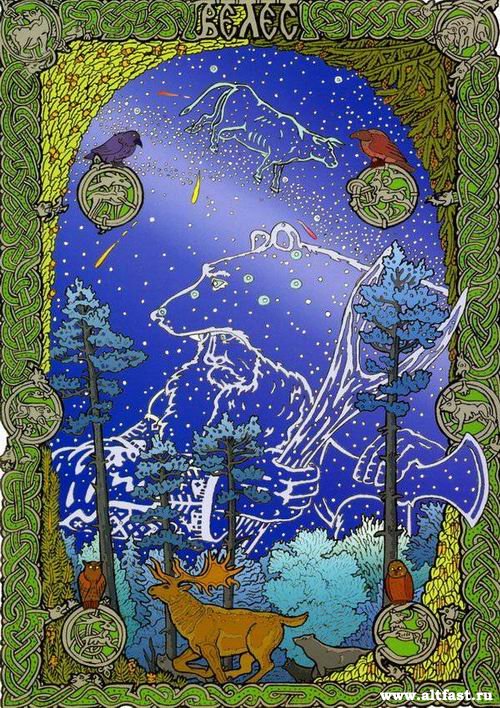
Velez, hair, volokh, volkhv, vedun, filament, elk, ox, forest, fox, wood goblin, fole, deer - all these words are connected with the forest. Veles children - that is how the Rus call themselves in the “Lay of Igor's Campaign”.
The Christians of Veles called them “the beast god”, but how can they be called cattle totem animals of Veles - a bear, a wolf, a sacred cow? No, the peoples of the natural and tribal system, animals were considered equal to people. For example, in Russia, bears are very fond and consider them brothers. And the bear is Velez. Veles has many images, including in the form of animals.
Rusichs learned a lot from animals, imitated them with voice, movements, methods of attack and defense.
Velez is an inexhaustible source of knowledge, each beast in its forest is unique. But people have moved away from nature - hence all the evils of modern civilization. It is time to realize that only a return to naturalness, to healthy natural principles can save the soul and body from final destruction.
We live in a mutilated world divided into religions, parties, estates, people are valued not for intelligence and strength, but for money, so humanity is withering and not developing spiritually. For spirituality is in our roots, and nowhere else. Spirituality - knowledge (Vedas). To know Ra (faith), to know Rod.
Velez is the keeper of antiquity and the silent bones of his ancestors. The last night of October is the day of the commemoration of grandfathers (in the West - Halloween). On this day, the Ruses saw off with bonfires and music of bagpipes and pipes of the spirits of nature and their relatives who died during the year under the snow.
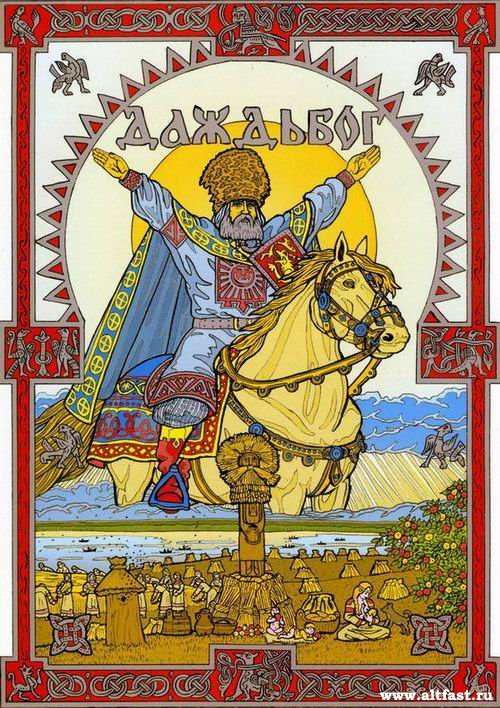
Dazhdbog, give, rain - the words of one root, meaning "to share, distribute." Dazhdbog sent people not only rain, but also the sun, sucking the earth with light and heat. Dazhdbog is an autumn sky with clouds, rains, thunderstorms, and sometimes hail.
September 22 is the autumnal equinox, the feast of the Kin and Rozhanits, the day of Dazhbog and Mokosh. The whole crop is taken off, the last gathering in the gardens and orchards is carried out. All residents of a village or city go out into nature, light a fire, drive a burning wheel-sun up the hill, lead a round dance with songs, play pre-wedding and ritual games. Then they take the tables to the main street, put the best food on them and start a common ancestral feast. Neighbors and relatives try their own food, cooked by others, praise, all together praise the Sun, the earth and Mother Russia.
Longyearly (sunny) grandchildren - this is how Rusichi called themselves. Symbolic signs of the sun (solar rosettes, solstices) were present everywhere in our ancestors - on clothes, dishes, in decorating houses.
Every Russian man is obliged to create a large family - race, feed, raise, raise children and become Dazhdbog. This is his duty, glory, true. For each of us are countless ancestors - our roots, and each must give life to the branches-descendants.
A man who has no children, in his old age is doomed to hunger, shame, poverty. The race should be big, healthy - our ancestors did not know vodka and smoke a thousand years ago, and therefore gave birth to strong and healthy knights and rozhanits-fret.
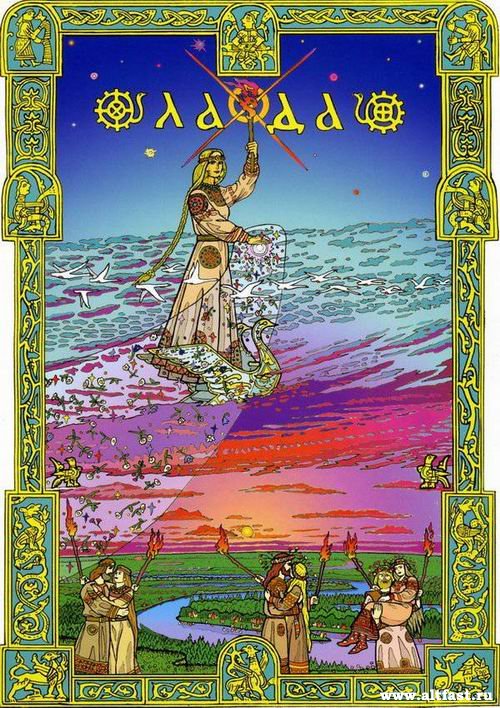
Lada, harmony, love, caress - all this speaks of the tender relationship between husband and wife in a family union, aimed at the birth of children and the extension of the Slavic family. Lada - a little girl born in spring with the first streams and snowdrops. Rooks, the first birds arriving home from warm countries, are heralds of the birth of the Lada. Together with Lada appear flowers and young foliage. Where the Lada passes, birds begin to sing. Animals also welcome the young goddess who brings them food after a long, starving winter.
Favorite birds of Lada - pigeons and swans - are compared in our mind with affection and loyalty. Therefore, the girls sing the words of spring with the voices of birds. Every girl in Russia - Lada.
Lada is gaining strength in Kupala, at this time she is treated with the rays of Yaryla, and in her womb a small month is born — the symbol of life. On June 22, the Slavs celebrate the summer solstice, huge bonfires are lit, a burning sun wheel rolls into the water (meaning the sun is “bathing”), there are round dances with shouts: “Burn, burn clearly, so as not to go out!” other love games, running after each other in the forest. Blud, according to Christians, in fact, for the holiday was not. Magi, old people, parents closely followed the youth and in the case of violation of the laws of morality expelled the guilty from the clan - it was at that time the most terrible punishment, because one could not live without relatives in antiquity.
Love in Russia was not a joy, but served to continue the race, conceive new children. It is the appearance of children is the meaning of the connection in pairs not only people, but also animals, birds. Only married couples left at the end of the holiday in the woods, under the canopy of warm mists, where they loved and loved until dawn, lighting numerous bonfires of love throughout Russia, turning the world into a huge burning fiery fern flower, a flower of truth, happiness, naturalness and eternity.
The arrival of Lada awakened the spirits of nature - the devils, field, watermen, mermaids.
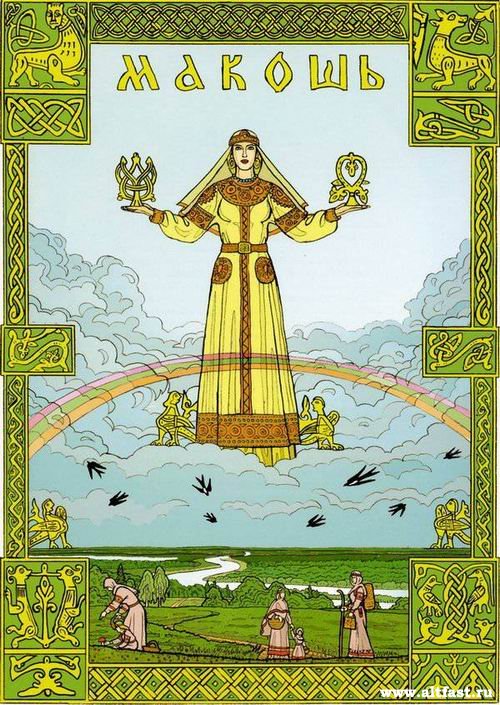
Makosh, mother, jackpot, purse, wallet (bag, soum), piggy bank, merchant - these words are related to each other and mean an increase in goodness and wealth.
If Lada is more related to spring water, then Makosh is the goddess of the earth, Mother-cheese is the earth. Women of antiquity learned to be makosh in their kin. A makosh is a woman who knows how to work in the field, in the garden, in the garden, in the forest, knows medicinal herbs, and knows how to raise and properly raise children. Makosh is a goddess who reveals witch secrets to women in summer (Morena - in winter).
Makosh - the goddess of life (some Slavic tribes called her Alive), she carries in her womb, growing after Kupala, a month (man).
The man in Russia symbolically represented the Tree. His parents, grandfathers and great-grandfathers are roots that go back to the depths of time, to hoary antiquity, and feed it with the vital sap of the family. The branches and crown of the tree are the future children and grandchildren whom every Rusich is looking forward to. He stretches his hands to the souls of the ancestors - the stars and to the main ancestor - the sun. The Slav does not ask them for favors, as Christians, but simply says - he assures them of his firm intention to have a family and children.
If, before marriage, a girl studied the work of Mokos, then, after getting married, she performs sacred maternal duties, giving birth and feeding children, teaching them goodness and the right attitude to nature and relatives. It is the sacred duty of all girls and women to be a makosh.
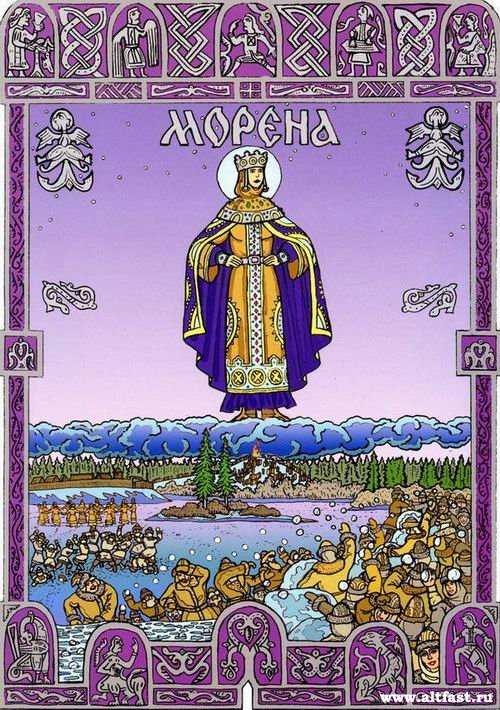
Moraine, sea, frost, drizzle (rain), sea, mara, heat haze, dead, dead, temper, wraith. All these words mean darkness, bitter cold, death, dampness or unbearable heat. Similar sensations visit the sick and dying. Morena is a goddess who fights with spring and, leaving, takes with her the remnants of the past year (cold, snow, darkness), giving way to a new life, spring.
March 22 comes the spring equinox, after which, as was believed in Russia, spring begins. Before the equinox our ancestors cheerfully celebrated Shrovetide. Again fires were kindled, again in cities and villages, as at Kolyada, young people gathered in groups, the most cheerful inventors were chosen for jokes, practical jokes; ice slides, snowball fortresses, swings and merry-go-rounds were made; they arranged skating on troika, hand-to-hand fighting and wall-to-wall battles, and finally - the capture of the snow town and the burning of the moraine effigy.
Immediately there was a contest - who will be the most agile and will be able to climb up the pole and get a rooster from there (he was revered as a symbol of the sun, dawn, spring and the goddess Lada - Morena girl), round cakes or boots. A burning wheel was rolled up from the mountain and bonfires were burned - a symbol of warmth and rebirth.
But Morena is not as terrible as it may seem. It is the image of our harsh snowy homeland, which tests everyone for strength and survival and takes only the weak. She loves the rigorous purity of the snow and the transparency of the ice, she is pleased with the dance of snowflakes in the deep winter sky. Morena's favorites are owls and lynxes. For the Russian people, the winter is sweet-winter, its invigorating cold, sparkling drifts and clear ice.
The symbol of Morena is the moon. Her face looks sternly at the ground, awakening in wolves a desire to howl, thickening fogs in the air and giving rise to the movement of water in lakes and seas.
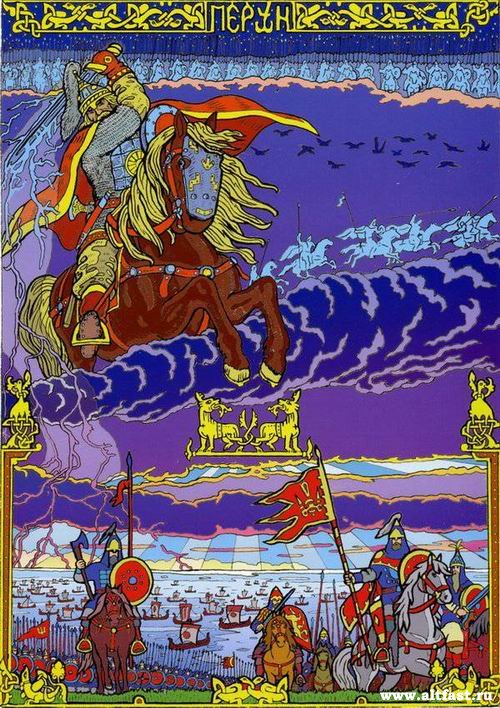
Perun, the rune (in Russia, these ancient letters were known as "features and cuts" mentioned in many written sources). Speech, stream, prophet, rumble, crash, Grae. Perun - the great god of Rus, god of war and thunder. His weapons are glittering swords, ax-axes, a huge rattling hammer, a club-mace, and a spear without a miss. The animals and birds of Perun - tours, wolves, crows, falcons. We love and honor Perun among the people. Fascinating his thundering thunderous voice. It shocks and arouses the awesome fear of the unearthly brilliance of its lightning weapon. Enrages the rapid flight of blue-lead clouds - his warriors.
Perun was especially revered in times of war and danger. In a bloody fight or during combat games, everyone tried to ignite in himself the fiery spirit of this terrible ancestor-god.
Although Perun was related to cold (it was born in the first month of winter), the Days of Perun - its time - began on June 20 and ended in early August. At this time, Rusichi was celebrating trizny on the soldiers who fell in battles - they gathered on the barrows and the Red Mountains, organized feasts, military fun, measured strength in running, throwing weapons, swimming, horse racing. They killed the bought bull, fried and ate it, drank honey and kvass. Conducted initiation of young men who had to pass serious tests in the warriors and gird themselves with the weapon of the Sort.
Our ancestors always had many external enemies, there were constant wars. The shield and sword were revered as a symbol of Perun, his gift to a man. Weapons were worshiped and idolized.
But it was not only men who went to a death fight. Often among the Russians killed on the battlefield, enemies with surprise found women fighting with their husbands shoulder to shoulder. They were also patronized by gold Perun ...
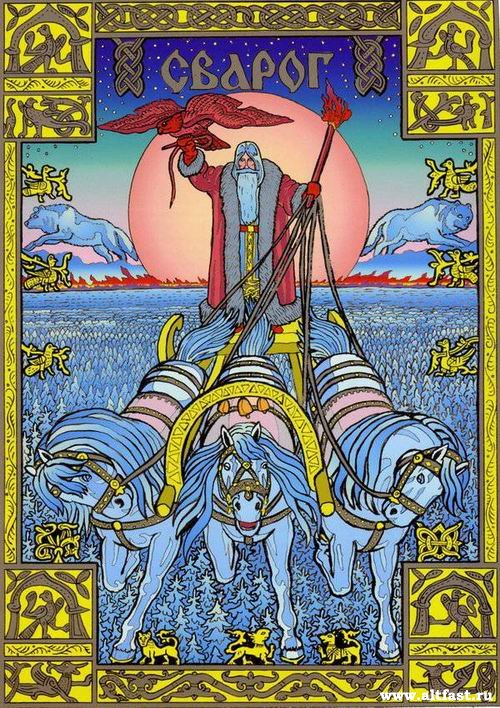
Svarog, boil, weld, light, holiness, reduce, color. These words are united by the idea of the creation of life (horn, rock, birth, speech, utter). Svarog - the greatest of the Russian gods. This is the progenitor, the great-grandfather who gave life, gave people knowledge and speech. He created the whole cosmos - the universe of Svarga. Svarog - in everything. Everything in the world is Svarog, its part. Among the Balts, he bears the name of Sotvaras, among the Iranians - Tvashtar, among the Romans - Saturn, among the Germans - Wodan, among the Etruscans - Satr, and so on - they all have consonant names and similarities. In the myths of the white nations, God forges a hammer with the hammer, creates peace, striking lightning and sparks, for all he has this or that relation to the sun.
Svarog is wise, he sits surrounded by our departed ancestors, intelligent birds and animals. Like an acorn that gave birth to a huge oak, this god gave birth to the Tree of Life. From Svarog-grandfather are the beginning of the gods and people, animals and birds - all living things. Svarog resides in every object, in every person, it is obvious, it can be seen, touched, heard.
Svarog - in Navi, in the past, but about him (about antiquity) remember. Svarog and rule, in the future, which we know and for which we live. He is in us, we are part of him, as are our descendants.
Svarog - the old sun, riding in a chariot, cold and dark.
Chernobog reigns in the last days of the year, when the longest night and strong cold. Rusichi bathe in the hole, joining the winter. Old-fashioned nature is silent, dressing in white snow clothes. People in the houses warm the windows, burn torches and eat what they grew in the summer, sing songs, tell tales, sew clothes, repair shoes, make toys, heat furnaces. And waiting for the birth of Horse, preparing outfits for caroling.
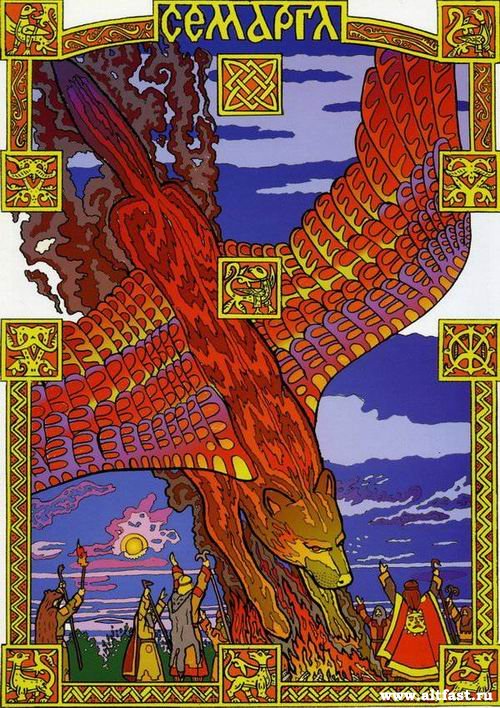
Semargl, stench, shimmer, Cerberus, Smargl dog, death - these concepts in their essence mean an otherworldly deity - a fiery wolf or a dog. The ancient Slavs are a fire wolf with the wings of a falcon, a very common image. The Russ saw Semargla as a winged wolf or a wolf with wings and a falcon's head, and sometimes its paws were falcons. If we recall the mythology, we will see that not only the horse was dedicated to the sun, but also the wolf and the falcon. It is worth looking at the chronicle letters, frames, ancient embroidery and decoration of houses, household utensils, armor and we will see that the wolf-falcon Semargl is found on them very often. For Rus, Semargl was just as important as a dragon for the Chinese, and a unicorn for the Celts.
The wolf and the falcon are impetuous, fearless (they attack the superior force of the enemy), they are devoted (the wolf, even being hungry, will not devour the kindred like a dog). Warriors often identified themselves with wolves (warrior wolf).
Do not forget that the wolf and the falcon purify the forest of weak animals, healing nature and making natural selection. Images of the gray wolf and falcon are often found in fairy tales, epics, songs, and ancient monuments of writing, such as the Word about Igor's regiment.
In every Slav lives Semargl, who fights against disease and evil in the human body. Drinker, smoker, lazy, degrading person kills his Semargl, falls ill and dies
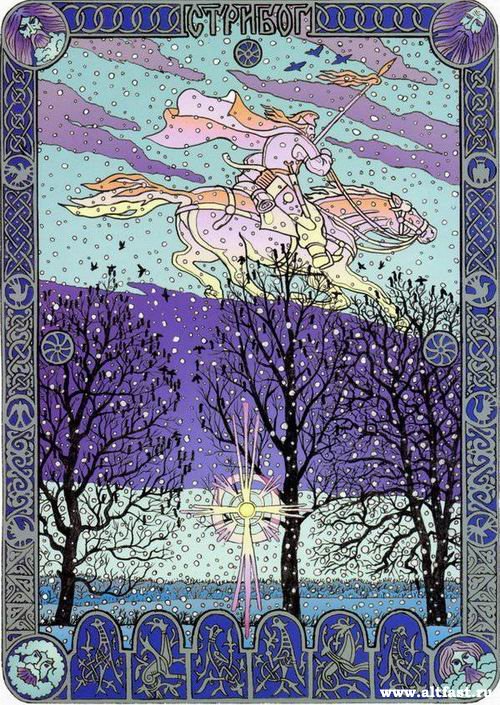
Stribog - swift, swift, fast, smart, aspiration, jet, and even, if you will, a string. All these concepts mean flow, speed, distribution, spreading. If we combine all this into one, we have the image of the wind and everything connected with it. This is the warm whiff of summer, the violent gust of rain and thunder, the hurricane, the tornado, the cold breath of the north, snowfall and styn.
Russia is the land of the north, and an icy midnight wind lives in it. Cold and hungry February is just his time, it is precisely in this month that the howling of hungry wolves, which Stribog with his icy breath drives to hunt, is especially long and frightening. Only crows bathe in the jets of the north wind. And at night, the fast shadows of predatory lynxes glide amidst the snowstorm, gleaming with yellow eyes and uttering a chilling meow.
In April, Stribog arrives from the east with a young warm day's breath. At night, he will breathe cold dampness.
In the summer, Stribog will blow from the afternoon (south), burning with heat during the day, and caressing with warmth at night. And in the fall, having flown from sunset (west), as in spring, it will warm during the day, and cool at night.
In autumn and spring, Stribog disperses the clouds, revealing the warm, bright sun. In the summer, he brings rain in a drought so that the harvest does not die, in winter he rotates the wings of the mills, grinding the grain into flour, from which he will then knead the bread.
Russ considered themselves Stribozhim grandchildren. Stribog is our breath, it is air in which words sound, smells spread and light is scattered, allowing to see the surroundings. Stribog is vital to all living things. He is the sovereign of the birds and is often depicted as a blowing head or a horseman.
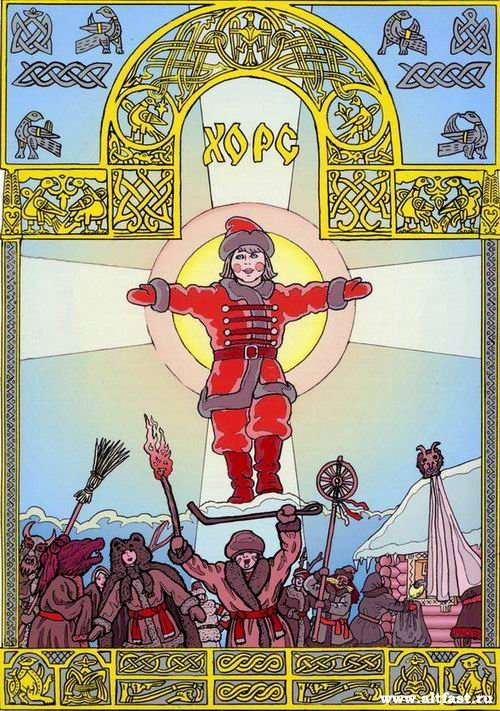
Horse, horost, brushwood, cross, cross, chair, spark, dance, horo, kolo, wheel, brace, stake, carols, circle, blood, red - all these words are related to each other and mean concepts associated with fire, around, in red. If you merge them into one, you will see the image of the sun, described allegorically.
The beginning of the new year, the Slavs celebrated December 22 - the winter solstice. It was believed that on this day a small, bright sun was born in the form of a boy - Khors. A new sun completed the course of the old sun (old year) and opened the course of the following year. While the sun is still weak, night and cold dominate the earth, inherited from the old year, but every day the Great Horse (as mentioned in "The Word of Igor's Regiment") grows and the sun grows stronger.
Our ancestors met the solstice with carols, wore a kolovrat (an eight-pointed star) on the pole - the sun, put on the disguise of totemic animals that were associated in the minds of people with images of ancient gods: the bear-Veles, the cow - the moss, the goat - a cheerful and at the same time evil incarnation of Veles , horse - sun, swan - Lada, duck- Rozhanitsa (progenitor of the world), rooster - a symbol of time, sunrise and sunset, and so on.
On the mountain they burned a wheel tied with straw, as if helping the sun to shine, then sledding, skating, skiing, playing snowballs, fists and wall-to-wall fights, songs, dances, competitions, games began. People went to visit each other, everyone tried to better treat those who had come, so that in the new year there was abundance in the house.
Severe northern Russia loved valiant fun. Forced to live and work in difficult conditions, our ancestors right up to the 20th century were considered to be a cheerful and hospitable people who could rest.
Horse is a male deity, embodying the desire of boys and adult husbands for knowledge, spiritual growth, self-improvement, to overcome the difficulties encountered in life and finding the right solutions.
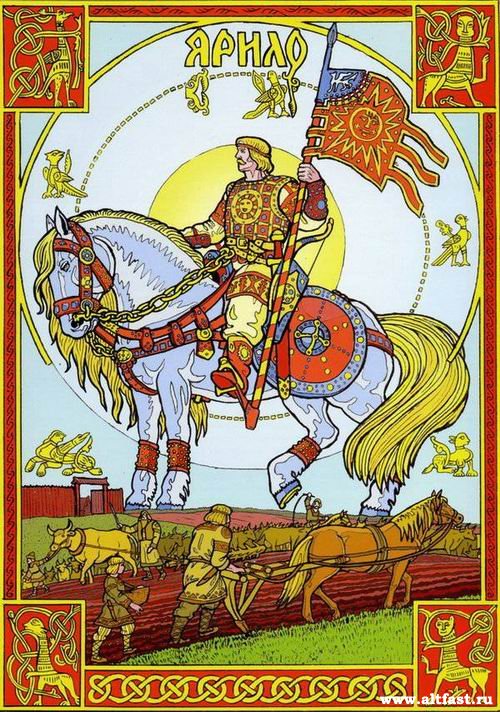
Yarilo, rage, spring, Yar (in the northerners in ancient times meant "village", as they used to live in huts with a hearth), brightness. These words are united by the concept of enhancing brightness, light. Indeed, after the arrival of spring comes the rapid addition of the day and the increase in heat. Everything comes to life, grows, stretches to the sun. Nature is resurrected in the image of the beautiful Lada. Yarilo, melting snow, lives mother - the earth with melt water.
Yarilo - the sun in the form of a young, full of strength of the groom rides a horse to his Lada. Hurries to start a family and give birth to children (crops, young animals, birds, fish, etc.).
By the summer solstice Yarilo is gaining full strength. He lives in truth and love with the earth, giving birth to new lives in the summer. By June 22, Yarilo turns into Belboga, the day is the longest, nature is favored by him and loves him. Yarila's condition is the condition of all young guys.
In the fourth month of the year (now April), the Rusichs began the most important agricultural work for the entire Slavic type: plowing, grazing, then hunting, fishing, horticulture, horticulture, and horticulture. Such was the life of the peasants (by the way, the word "peasant" came from "cross, armchair, Horse", and "fireman" from "fire" that they plant in the furnace).
Readers may have the erroneous opinion that some gods served the Slavs as the embodiment of evil, others - good. No, rusichi, children of nature, took it in all forms, knew how to be useful to her and gratefully take from her what they need. Gods, as well as people, combined in themselves both beginnings - both positive, and negative. For example, Yarilo gives heat and light, but if it is unwise to use them, there will be sunstroke. And Morena, though cold, helped Russia more than once, having frozen the troops of Hitler and Napoleon.
 magicov.ru Secrets of magic.
magicov.ru Secrets of magic.
